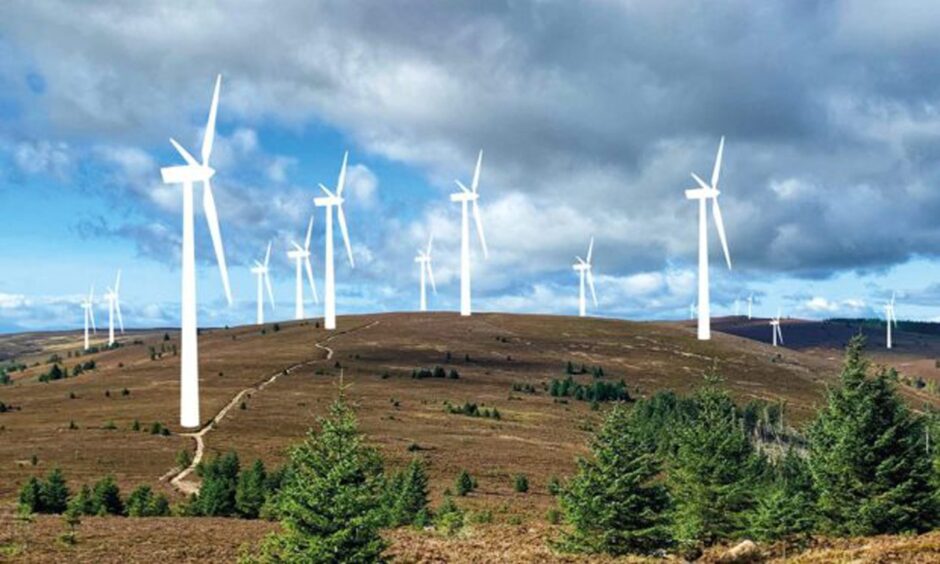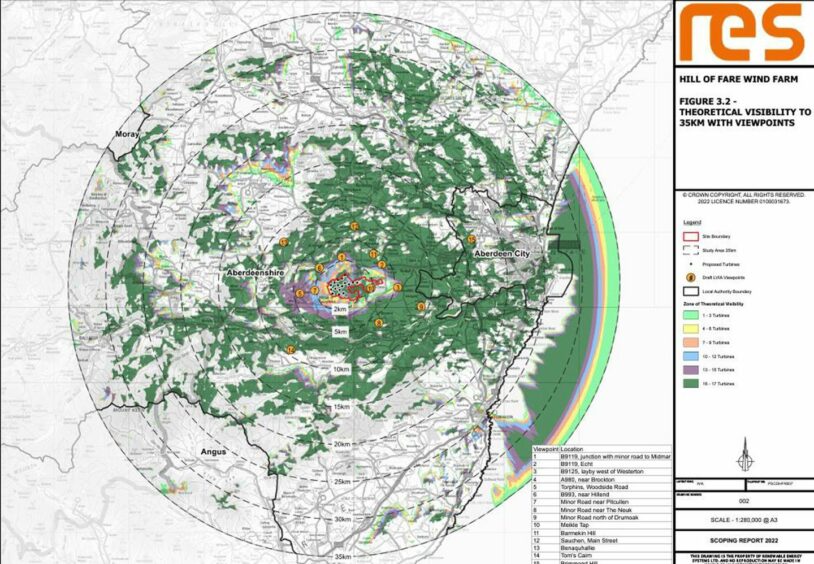
The proposed Hill of Fare wind farm, located less than four miles from Banchory, has faced criticism as concerns have been raised around radiation at the site.
A local campaign group, Hill of Fare Windfarm Information Group (HoFWIG), say that there are levels of radiation where developer RES aims to build its renewable energy project. Concerns have been raised that construction at this location may impact local residents, watercourses, and the environment.
This is not the first time that Hill of Fare has received pushback, initial plans were deemed “simply too big” by local politicians as locals spoke out against the project.
Following a consultation period last year RES revised its designs to include 11 turbines that will stand at 590ft and 5 turbines at 656ft.
Under previous plans from developer RES, the turbines would have been “theoretically visible” with viewpoints from 20 miles away in all directions, from Moray to Angus, according to planning documents.
The initial plans would have seen up to 17 turbines, the highest of which would stand at some 820ft, come to Aberdeenshire.
Recently a local community group, Nae Fare, formed to oppose the project following news that 71% of people attending the Hill of Fare wind farm consultation were against the project.
The latest gripe raised by HoFWIG campaigner, Frank Murray, centres around radiation at the site and RES’ lack of signalling around it.
Mr Murray said: “A key area that the developers, global renewable power generators, RES, have failed to consider is the health, safety, and environmental issues of Hill of Fare’s high radiation levels.
“In particular, the impact of intrusive construction work and what this would mean for residents, watercourses, and the environment – but also for the workforce.”
Mr Murray and his fellow HoFIG campaigners said that in the late 1970s, the risks of contamination surrounding exploratory drilling for uranium on Hill of Fare were raised by the local council, and by Friends of the Earth.
In 2016 the Scottish Government looked into utilising the levels of radiation found in the Hill of Fare’s granite deposits as heat sources in a geothermal project.
Mr Murray continues: “RES has made no mention of the potential challenges and impact of Hill of Fare’s radiation levels.”
The local resident questioned: “What guarantees can be made about the safety of our water courses? Will our drinking water and air be contaminated with radiological matter during blasting? What protective measures will be put in place to ensure the safety of any future workforce? What will happen to the industrial and potentially contaminated waste?”
However, RES says that “radiation has not been raised as a matter of concern by any statutory consultee” and that the Hill of Fare project site was “thoroughly scoped” before planning applications were sent.
A RES spokesman told Energy Voice: “The Section 36 Application for this wind farm is currently with the Scottish Government’s Energy Consents Unit and is open for consultation.
“As part of this consultation process, we have already received a response from Scottish Water, who have not objected.
“The protection of existing watercourses and private water supplies is of the upmost importance to RES and, if required, appropriate mitigation measures agreed with the relevant statutory consultees would be put in place.”
Estimated £150 million to local economy
The developers also pointed to the advantages the project can bring to the region, namely the estimated £150 million it could bring to Aberdeenshire.
In the planning applications submitted by RES late last year, the firm predicted that its renewable energy project would deliver £14 million of investment in Aberdeenshire during construction and a further £66m of economic activity linked to operations and maintenance work, during the wind farm’s operational life.
In addition to this, the firm says that around £50m could be paid in business rates to Aberdeenshire Council off the back of this development, alongside a proposed community benefit package of over £26m.
Recommended for you


 © Supplied by RES
© Supplied by RES © Supplied by DCT Graphics
© Supplied by DCT Graphics